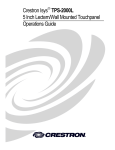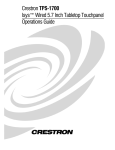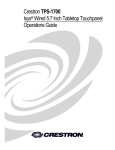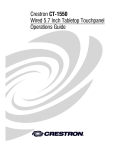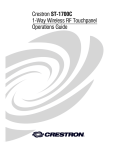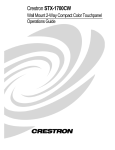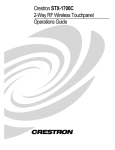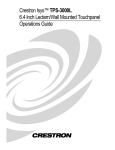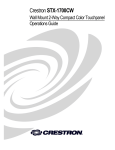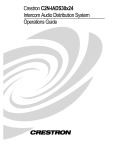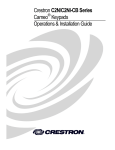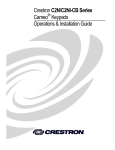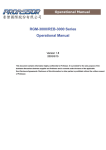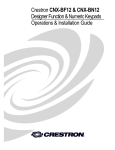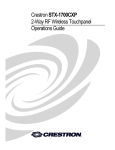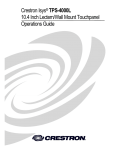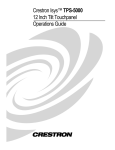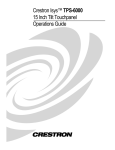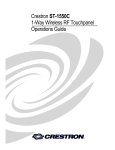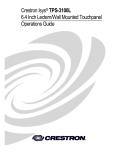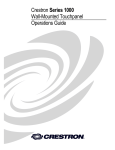Download Crestron TPS-3000 Specifications
Transcript
Crestron Isys® TPS-3000 6.4 Inch Tilt Touchpanel Operations Guide This document was prepared and written by the Technical Documentation department at: Crestron Electronics, Inc. 15 Volvo Drive Rockleigh, NJ 07647 1-888-CRESTRON All brand names, product names and trademarks are the property of their respective owners. ©2005 Crestron Electronics, Inc. Crestron Isys® TPS-3000 6.4 Inch Tilt Touchpanel Contents 6.4 Inch Tilt Touchpanel: Crestron Isys® TPS-3000 1 Introduction ............................................................................................................................... 1 Features and Functions ................................................................................................ 1 Specifications .............................................................................................................. 2 Physical Description.................................................................................................... 5 Industry Compliance ................................................................................................... 9 Setup .......................................................................................................................................... 9 Network Wiring........................................................................................................... 9 Identity Code ............................................................................................................. 10 Configuring the Touchpanel...................................................................................... 10 Hardware Hookup ..................................................................................................... 17 Recommended Touchscreen Cleaning ...................................................................... 20 Tilt Angle Tension Adjustment ................................................................................. 21 Programming Software ............................................................................................................ 21 Earliest Version Software Requirements for the PC ................................................. 22 Programming with Crestron System Builder............................................................. 22 Programming with SIMPL Windows ........................................................................ 23 Programming with VisionTools Pro-e....................................................................... 27 Reserved Join Numbers............................................................................................. 28 MultiByte International Characters ........................................................................... 31 Uploading and Upgrading........................................................................................................ 31 Communication Settings ........................................................................................... 32 Uploading a SIMPL Windows Program to a Control System ................................... 34 Uploading a VT Pro-e Project ................................................................................... 35 Firmware Upgrade..................................................................................................... 37 Problem Solving ...................................................................................................................... 39 Troubleshooting......................................................................................................... 39 Further Inquiries ........................................................................................................ 40 Future Updates .......................................................................................................... 40 Software License Agreement................................................................................................... 41 Return and Warranty Policies .................................................................................................. 43 Merchandise Returns / Repair Service ...................................................................... 43 CRESTRON Limited Warranty................................................................................. 43 Operations Guide – DOC. 6076A Contents • i Crestron Isys® TPS-3000 6.4 Inch Tilt Touchpanel 6.4 Inch Tilt Touchpanel: Crestron Isys® TPS-3000 Introduction Features and Functions The TPS-3000 is a member of the signature family of Crestron® touchpanels. It packs all the power and performance of an Isys® touchpanel in a stylish model that offers amazing ergonomics and one-hand control. Its compact stature makes the TPS-3000 perfect for the home, especially in locations like home theaters, bedrooms and the home office. Functional Summary • • • • • • • • • • • • • • • • • 6.4" (1.26 cm) active matrix color display 65,563 colors 640 x 480 screen resolution 16-bit non-palette graphics 8 Mb of Flash & 8 Mb of DRAM memory Built-in time-based correction for stable video and graphics Balanced/unbalanced composite video and S-video input; supports NTSC/PAL formats Full screen video capability Up to 4,000 digital and analog signals; up to 999 serial signals Built-in microphone and two speakers (half duplex intercom capable) Stores and plays back WAV sound files Stereo headphone jack Fast graphics performance: import photographs, drawings, and icons Support for downloadable fonts – proportional* and non-proportional Foreign language text Position lock feature provides durable support of panel at any angle of inclination between 30 and 80 degrees Includes a TPS-IMPC for system connection * Proportional fonts: the width of each character differs with the character shape, for example, the letter M is wider than the letter I. All characters in non-proportional fonts are spaced equally. The TPS-3000 features a 6.4-inch (16.26 cm) active matrix display that provides the finest quality video and graphics available on a screen of its size. The TPS-3000 also features the 65,563-color Isys engine, which produces a graphic display of incredible brightness and depth. Multiple graphics can be displayed on the TPS-3000 without Operations Guide – DOC. 6076A 6.4 Inch Tilt Touchpanel: Crestron Isys® TPS-3000 • 1 Crestron Isys® TPS-3000 6.4 Inch Tilt Touchpanel any shift in color depth or quality. The TPS-3000 also supports real-time video as standard and can accommodate any Crestron balanced video distribution product. The TPS-3000's audio capabilities include stereo audio speakers that offer built-in volume control, a built-in microphone and built-in WAV sound file capability. Sound can be generated by the panel by using downloaded wave files (.WAV) or can be mixed in from an external line level audio source. The audio amplifiers output 2 Watts per channel. A built-in microphone in the touchpanel is amplified to produce a line level differential output. The microphone amplifier has two modes, AGC or fixed gain. The AGC is selectable using an internal join number, refer to “Reserved Join Numbers” on page 28. A "Dynamic range" compression feature is provided for the TPS-3000. When enabled, the audio amplifier gain is reduced dynamically for loud signal levels, thus eliminating most distortion at the speakers. For quiet audio signals, the gain is not reduced. When "Dynamic range" compression is turned off (default), the audio amplifier gain remains fixed for all signal levels at the given volume setting. The "RS-232 Port for Touch Output" operation is similar to TPS-5000/6000. When selected, touch coordinates are transmitted to external devices via RS-232 for processing commands. Specifications The following tables provide a summary of specifications for the TPS-3000 touchpanel. Specifications for the TPS-3000 Touchpanel SPECIFICATION DETAILS Cresnet Power Usage 22 Watts (0.92 Amp @ 24 VDC) Not including TPS-IMPC (1.0 W) Default Net ID 03 Timeout Adjustable from 0 to 120 minutes (Default = 10 min.) Signal Join Maximums 4000 Digital, 4000 Analog, 999 Serial Control System Update Files1,2,3 2-Series Control System Version C2-2004.CUZ or later CEN/CN-TVAV Version 5.13.12V.UPZ or later CNMSX-AV/PRO Version 5.12.63X.UPZ or later CNRACKX/-DP Version 5.07.06W.UPZ or later ST-CP Version 4.02.04S.UPZ or later Continued on the following page 2 • 6.4 Inch Tilt Touchpanel: Crestron Isys® TPS-3000 Operations Guide – DOC. 6076A Crestron Isys® TPS-3000 6.4 Inch Tilt Touchpanel Specifications for the TPS-3000 Touchpanel (Continued) SPECIFICATION DETAILS Acceptable File Extensions4 SIMPL Windows .smw .spz .bin .csz projectname.smw (source file) projectname.spz (compiled file for 2-Series) projectname.bin (compiled file for CNX generation) projectname.csz (compiled file for CNX generation with SIMPL+) VT Pro-e .vtp .vtz Firmware .csf Audio Video projectname.vtp (source file) projectname.vtz (compiled file) TPS-3000xxxxxx.csf (panel firmware) • Balanced (20 kΩ) & unbalanced (10 kΩ) line level stereo input through TPS-IMPC/IMW • Maximum input level 2Vrms single ended, 4Vrms differential with internal volume control and two speakers. • Balanced line level microphone with AGC output via TPS-IMPC/IMW • Maximum output level 1Vrms single ended, 2Vrms differential • Built-in WAV file (8bit 8kHz mono PCM type & key click capability • Stereo headphone mini-phone jack on rear of unit • Speaker amplification: 2 Watts per channel • Microphone: 600 Ohms balanced and 300 Ohms unbalanced mic out • Direct Composite/S-video input through TPS-IMPC/IMW, Balanced 100 Ω, Unbalanced 75 Ω. • Built-in time base correction for stable video and graphics • Video can be displayed full screen or in a window • NTSC and PAL supported • De-interlaced (still) and line doubled (motion) modes are supported • Brightness, contrast, hue and saturation adjustments Memory 5 8MB internal flash memory (7MB for user display lists), 8MB of DRAM Screen Dimensions 6.4"/16.3 cm diagonal Screen Viewing Angles: Y Dir. (X=0o): +40o (from top), -55o (from bottom) X Dir. (Y=0 ): +60 (from right), -60 (from left) Screen Resolution 640 x 480 pixels Color 16 Bit non-palette graphics with color key video window capability, 64,000 colors o o o Continued on the following page Operations Guide – DOC. 6076A 6.4 Inch Tilt Touchpanel: Crestron Isys® TPS-3000 • 3 Crestron Isys® TPS-3000 6.4 Inch Tilt Touchpanel Specifications for the TPS-3000 Touchpanel (Continued) SPECIFICATION DETAILS Display Type Touch-sensitive active matrix color LCD Enclosure Injection-molded plastic faceplate in black and silver CPU 63MIPs Coldfire processor running Isys generation firmware Cresnet® Via TPS-IMPC/IMW RS-232 RJ-11 connector for console Operating Temperature and Humidity 50º to 113º F (10º to 45º C), Dimensions and Weight Height: 7.56 in (19.21 cm) Default settings: 115200, 8 bit, parity none, stop bit 1 10 to 90% Relative Humidity (non-condensing) Width: 8.40 in (21.34 cm) Depth: 7.21 in (18.32 cm) Weight: 3.44 Lbs. (1.56 kg) without IMPC unit 4.02 Lbs. (1.82 kg) with IMPC unit Additional Options • HBK-3000 cable management hatchback also ensures that unauthorized users cannot disconnect the cables • SMK-3000 rotating base kit (330 degrees) also reduces the chance of theft and includes the HBK-3000 hatchback 1. The latest versions can be obtained from the Downloads | Software Updates section of the Crestron website. Refer to NOTE after last footnote. 2. Crestron 2-Series control systems include the AV2 and PRO2. Consult the latest Crestron Product Catalog for a complete list of 2-Series control systems. 3. CNX update files are required for either CNMSX-AV/PRO or CNRACKX/-DP. Filenames for CNX update files have a UPZ extension and ST-CP files are in one EXE or zipped UPZ file. To avoid program problems, make certain you are using the update file with the correct suffix letter (e.g., S, V, W, X). 4. Extension requires a prefix specific to the touchpanel type. In DETAILS, projectname represents the assigned project name, and xxxxxx represents a version number. 5. The memory in a TPS-3000 is not upgradeable. NOTE: Crestron software and any files on the website are for Authorized Crestron dealers only. New users are required to register to obtain access to certain areas of the site (including the FTP site). 4 • 6.4 Inch Tilt Touchpanel: Crestron Isys® TPS-3000 Operations Guide – DOC. 6076A Crestron Isys® TPS-3000 6.4 Inch Tilt Touchpanel Physical Description The 6.4-inch (16.26 cm) touch sensitive viewing screen is located on the front of the TPS-3000 touchpanel. The electronic hardware is housed in a black and silver molded plastic enclosure, shown after this paragraph. This touchpanel is designed for placement on a tabletop or other flat surface. It possesses a hinged base, which can tilt from 30 to 80 degrees. All audio, RS-232, video, network, and power connections are made at the rear panel on the base of the unit. A grille located on the base of the unit conceals two speakers and the microphone is located at the top center of the touchscreen. Front View Operations Guide – DOC. 6076A 6.4 Inch Tilt Touchpanel: Crestron Isys® TPS-3000 • 5 6.4 Inch Tilt Touchpanel Crestron Isys® TPS-3000 Back View with HBK-3000 (Hatchback Option Sold Separately) Optional Hatchback HBK-3000 Optional SMK-3000 (Rotating Base Accessory Sold Separately and Includes HBK-3000) 6 • 6.4 Inch Tilt Touchpanel: Crestron Isys® TPS-3000 Operations Guide – DOC. 6076A Crestron Isys® TPS-3000 6.4 Inch Tilt Touchpanel Physical View of the TPS-3000 Touchpanel (Front) Physical View of the TPS-3000 Touchpanel (Side) Operations Guide – DOC. 6076A 6.4 Inch Tilt Touchpanel: Crestron Isys® TPS-3000 • 7 6.4 Inch Tilt Touchpanel Crestron Isys® TPS-3000 Physical View of the TPS-3000 Touchpanel (Bottom) Physical Views of the TPS-3000 Touchpanel (Back) 8 • 6.4 Inch Tilt Touchpanel: Crestron Isys® TPS-3000 Operations Guide – DOC. 6076A Crestron Isys® TPS-3000 6.4 Inch Tilt Touchpanel Industry Compliance As of the date of manufacture, the TPS-3000 has been tested and found to comply with specifications for CE marking and standards per EMC and Radiocommunications Compliance Labelling. NOTE: This device complies with part 15 of the FCC rules. Operation is subject to the following two conditions: (1) this device may not cause harmful interference, and (2) this device must accept any interference received, including interference that may cause undesired operation. Setup Network Wiring CAUTION: In order to ensure optimum performance over the full range of your installation topology, Crestron Certified Wire, and only Crestron Certified Wire, should be used. Failure to do so, may incur additional charges if support is required to identify performance deficiencies as a result of using improper wire. CAUTION: Provide sufficient power to the system. Insufficient power can lead to unpredictable results or damage to the equipment. Please use the Crestron Power Calculator to help calculate how much power is needed for the system (http://www.crestron.com/calculators). CAUTION: Use only Crestron power supplies for Crestron equipment. Failure to do so could cause equipment damage or void the Crestron warranty. NOTE: When installing network wiring, refer to the latest revision of the wiring diagram(s) appropriate for your specific system configuration, available from the Crestron website. When calculating the wire gauge for a particular Cresnet® run, the length of the run and the Cresnet power usage of each network unit to be connected must be taken into consideration. If Cresnet units are to be daisy-chained on the run, the Cresnet power usage of each unit to be daisy-chained must be added together to determine the Cresnet power usage of the entire chain. If the unit is a home-run from a Crestron system power supply network port, the Cresnet power usage of that unit is the Cresnet power usage of the entire run. The length of the run in feet and the Cresnet power usage of the run should be used in the resistance equation below to calculate the value on the right side of the equation. Resistance Equation Operations Guide – DOC. 6076A 6.4 Inch Tilt Touchpanel: Crestron Isys® TPS-3000 • 9 Crestron Isys® TPS-3000 6.4 Inch Tilt Touchpanel The required wire gauge should be chosen such that the resistance value is less than the value calculated in the resistance equation. Refer to the following table. Wire Gauge Values RESISTANCE WIRE GAUGE 4 16 6 18 10 20 15 22 13 Doubled CAT5 8.7 Tripled CAT5 NOTE: All Cresnet wiring must consist of two twisted pairs. One twisted pair is the +24V conductor and the GND conductor, and the other twisted pair is the Y conductor and the Z conductor. NOTE: When daisy-chaining Cresnet units, strip the ends of the wires carefully to avoid nicking the conductors. Twist together the ends of the wires that share a pin on the network connector, and tin the twisted connection. Apply solder only to the ends of the twisted wires. Avoid tinning too far up the wires or the end becomes brittle. Insert the tinned connection into the Cresnet connector and tighten the retaining screw. Repeat the procedure for the other three conductors. NOTE: For additional general information on video connections over CAT5, refer to the latest version of the Crestron CAT5 Wiring Reference Guide (Doc. 6137) which is available from Crestron website. NOTE: For larger networks (i.e., greater than 28 network devices), it may be necessary to add a Cresnet Hub/Repeater (CNXHUB) to maintain signal quality throughout the network. Also, for networks with lengthy cable runs or varying types of network devices, it may be desirable to add a hub/repeater after only 20 network devices. Identity Code Every equipment and user interface within the network requires a unique Cresnet Identity code (Net ID). These codes are assigned a two-digit hexadecimal number from 03 to FE. Refer to "Interface Menu” on page 12 for instructions on setting the unit's Net ID. The Net ID of the unit must match the Net ID specified in the SIMPL Windows program. Refer to “Setting the Net ID in Device Settings” on page 24 for an example of a SIMPL Windows program. Configuring the Touchpanel NOTE: The only connection required to configure the touchpanel is power (supplied via Cresnet). Refer to “Hardware Hookup” on page 17 for details. To configure the unit, it may be necessary to access a series of setup screens prior to viewing run-time screens that are loaded into the touchpanel for normal operation. The MAIN MENU for configuring the touchpanel appears when a finger is held to 10 • 6.4 Inch Tilt Touchpanel: Crestron Isys® TPS-3000 Operations Guide – DOC. 6076A Crestron Isys® TPS-3000 6.4 Inch Tilt Touchpanel the touchscreen as power is applied. Remove your finger when the message "SETUP MODE" appears on the touchscreen. Upon entering SETUP MODE, the MAIN MENU, shown below, displays four buttons: Touch Screen Calibration, Exit and Run Program, Setup, and Diagnostics. The Exit and Run Program button verifies that all of the setup information has been saved to the EEPROM and displays the main page that has been programmed into your system. The remaining buttons on the MAIN MENU open other menus, which are discussed in subsequent paragraphs. MAIN MENU This menu can also be obtained via digital reserved join number 17242. Calibration Menu Calibration of the touchscreen is required if the active touch area of a button does not coincide with the button's image. Select the Touch Screen Calibration button to display the CALIBRATION MENU, shown below. The CALIBRATION MENU offers the choice to initiate calibration with the Perform Calibration button or return to the previous screen with the Return button. Choose an option by touching the correct button. If you proceed to calibrate the touchpanel, the screen displays the message "Touch Upper Left" centered on the panel with a cross hair in the corner. Touch the cross hair in the corner of the screen to initiate calibration. Another message, "Touch Upper Right", appears with a cross hair in the correct corner. Touch the corner of the screen. A final message, “Touch Lower Right”, appears with a cross hair in the correct corner. Touch the corner of the screen to conclude calibration and return to the MAIN MENU. CALIBRATION MENU NOTE: When touching the screen during calibration, be as accurate as possible. Use the tip of a capped pen or the eraser end of a pencil. To cancel calibration and return to the CALIBRATION MENU without saving calibration data, create a calibration error by touching the screen in the same spot three times. Operations Guide – DOC. 6076A 6.4 Inch Tilt Touchpanel: Crestron Isys® TPS-3000 • 11 6.4 Inch Tilt Touchpanel Crestron Isys® TPS-3000 Setup Menu To obtain the SETUP MENU, shown below, press the Setup button from the MAIN MENU. The SETUP MENU offers a series of buttons, which opens additional menus and displays, which are detailed in subsequent paragraphs. After setup parameters have been set, select the Return button to return to the MAIN MENU. SETUP MENU NOTE: For convenience, the current CRESNET ID setting is displayed in the lower left corner. NOTE: All touchpanel settings are automatically saved in non-volatile memory. Interface Menu The touchpanel communicates with a control system to activate commands or to display feedback from components within the system. The communication interface must be correctly specified or communication will not occur. To set communication parameters select the Interface button located on the SETUP MENU and display the INTERFACE MENU, shown below. The Cresnet network identity number (CRESNET ID) is displayed on the INTERFACE MENU. CRESNET ID is the two-digit hexadecimal number. The hexadecimal number can range from 03 to FE and must correspond to the Net ID set in the SIMPL Windows program of the Cresnet system. Matching IDs between touchpanel and SIMPL Windows program is required if data is to be successfully transferred. Net ID for the TPS-3000 is factory set to 03 and no two devices in the same system can have the same ID. INTERFACE MENU Two buttons adjacent to the hexadecimal display, UP and DOWN, increase and decrease the CRESNET ID by one, respectively. Select the Return button located on the INTERFACE MENU to return to the SETUP MENU. 12 • 6.4 Inch Tilt Touchpanel: Crestron Isys® TPS-3000 Operations Guide – DOC. 6076A Crestron Isys® TPS-3000 6.4 Inch Tilt Touchpanel Audio Menu Audio is a useful feedback tool and it can be used to enhance a custom interface. To obtain the AUDIO MENU, shown below, press the Audio button from the SETUP MENU. The AUDIO MENU offers a series of buttons, which opens additional screens and each is detailed in a table after this paragraph. Two of the buttons on the AUDIO MENU perform a function directly. The Restore Default Settings button returns all audio parameters to their default settings when the button is selected. After audio parameters have been set, select the Return button to return to the SETUP MENU. AUDIO MENU Audio Setup Details AUDIO MENU BUTTON 1 AUDIO SETUP SCREEN Master 88% Master Volume WAV 88% (On) WAV Enable WAV files with the WAV On button. WAV Off disables this feature. Adjust the volume with the UP and DOWN buttons. Select the Play WAV File to sample and adjust the volume as a pre-loaded WAV file plays. Line 88% (On) Line Enable line level audio with the Line On button. Line Off disables this feature. Adjust the volume with the UP and DOWN buttons. All Audio (On) All Audio Control All types of audio may be disabled with a single button press. All Audio Off activates global muting. All Audio On enables all audio. Key Click Enabled (Vol. 83%) Key Click Click On enables the key click sound, Click Off disables the key click. Adjust the volume with the UP and DOWN buttons. Mic AGC On AGC3 The built-in microphone AGC (Automatic Gain Control) is enabled by the Mic Audio AGC On button and disabled with the Mic Audio AGC Off button. Treble & Bass (49%) Treble & Bass Two UP and DOWN buttons allow independent treble and bass adjustment. Operations Guide – DOC. 6076A DESCRIPTION 2 The volume of all audio types (WAV, line, and key click) is affected by the Master Volume control. If the Master Volume control is set to 100%, the volume for any type of audio is at maximum. If the Master Volume is set to 0%, the value of all audio types is overridden and the touchpanel is silent. If Master Volume is a percentage (say 50%), then all audio types can only achieve half their value. 1. The button text shown demonstrates the default audio setting for a given button. The items in parenthesis are also default values, but are seen in subsequent screens. 2. Each screen has its own Return button to revert to the AUDIO MENU. Selected buttons are shown in red on the touchpanel. 3. AGC is a means of automatically controlling the gain of the amplifier in order to maintain a constant level over a limited range. 6.4 Inch Tilt Touchpanel: Crestron Isys® TPS-3000 • 13 Crestron Isys® TPS-3000 6.4 Inch Tilt Touchpanel Video Menu The TPS-3000 can display balanced and unbalanced composite video and S-video input supporting both NTSC/PAL formats from any Crestron video distribution system. Select the Video button from the SETUP MENU to display the video screen, shown below. Selecting Select Input specifies the type of video source signal. The touchpanel can be configured to auto-detect (S-video or composite) or can be set to a specific connection type (S-video or composite). Select the appropriate input mode. The Show Controls button on the video screen offers another screen with a series of buttons, each is detailed in a table after this paragraph. After video parameters have been set, select the Return button to return to the SETUP MENU. VIDEO SCREEN Video Setup Details VIDEO SCREEN BUTTONS1 DESCRIPTION 2 Brightness UP button increases video image brightness, DOWN button decreases video image brightness. Contrast UP button increases video image contrast, DOWN button decreases video image contrast. Saturation UP button increases video image saturation, DOWN button decreases video image saturation. Hue UP button increases video image hue, DOWN button decreases video image hue. Still/Motion (toggle) The Motion setting eliminates the motion artifacts caused by the difference between first and second halves of a video frame field. The Still setting yields a much sharper image, however, motion artifacts may occur if fast moving objects are displayed. Hide Controls This button returns the display to the video screen. Default Returns you to the default settings. You are prompted with “Are you sure?” Answering YES to the prompt returns you to default settings. Answering NO to the prompt returns you to the previous screen. Return Reverts to the SETUP MENU 1. Video default is 50% for each of the video parameters (brightness, contrast, saturation, and hue). 2. Each screen has its own Return button to revert to the SETUP MENU. 14 • 6.4 Inch Tilt Touchpanel: Crestron Isys® TPS-3000 Operations Guide – DOC. 6076A Crestron Isys® TPS-3000 6.4 Inch Tilt Touchpanel Timeout Menu The touchpanel display can be turned off (standby mode) when not in active use. Select the Timeout button on the SETUP MENU to reveal the TIMEOUT SETTINGS display, shown below. This setting turns the display off when the touchpanel is inactive for a specified time. Touch the screen to awaken the touchpanel and the last screen to be displayed reappears. The time value, represented by XXX in the illustration, can range from 0 (disables the timeout) to 120 (minutes). Two buttons, UP and DOWN, increase and decrease the timeout, respectively. Select the Return button to save the timeout setting and return to the SETUP MENU. TIMEOUT SETTINGS RS-232 Menu The touchpanel allows for one of four RS-232 communication modes: console (i.e. loading programs) control (i.e. non-Crestron device), touch output (communication of touch coordinates to an external device) or external touch screen input. For convenience, the RS-232 Menu also permits the selection of the RS-232 communication options, RTS-CTS On, RTS-CTS Off, XON-XOFF On, XON-XOFF Off, Baud Rate, Data Bits, Parity, and Stop Bits. Touch the communication option to select communication parameters and then select Save and Return to save the RS-232 settings and return to the SETUP MENU. Default settings: Console mode, Baud rate: 115200, data bits: 8 bit, parity: none, stop bit: 1, XON/XOFF on, RTS/CTS off. RS-232 SETTINGS Operations Guide – DOC. 6076A 6.4 Inch Tilt Touchpanel: Crestron Isys® TPS-3000 • 15 6.4 Inch Tilt Touchpanel Crestron Isys® TPS-3000 Screen Settings The touchpanel screen brightness may require adjustment because of ambient light conditions or personal preference. The brightness can be set via programming or altered manually from the SCREEN SETTINGS display, shown below. Press the Screen Settings button from the SETUP MENU to access this screen. To return to the SETUP MENU and save screen settings, select the Return button on the SCREEN SETTINGS display. The current screen brightness setting is shown on this page. The screen brightness is factory set to 100%. Changes to the brightness level are performed on a subsequent screen after selecting the Brightness button. SCREEN SETTINGS Press the Brightness button to open the SCREEN SETTINGS – BRIGHTNESS display. Manual changes to the screen brightness are made with the UP and DOWN buttons. To return to the SCREEN SETTINGS display and save the brightness settings, press Return. SCREEN SETTINGS-BRIGHTNESS 16 • 6.4 Inch Tilt Touchpanel: Crestron Isys® TPS-3000 Operations Guide – DOC. 6076A Crestron Isys® TPS-3000 6.4 Inch Tilt Touchpanel Diagnostics Menu The Diagnostics button from the MAIN MENU should only be used under supervision from a Crestron customer service representative during telephone support. The options available from the DIAGNOSTICS MENU, shown below, are numeric in nature and their interpretation is beyond the scope of this manual. DIAGNOSTICS MENU Hardware Hookup CAUTION: Do not apply excessive pressure to the touchscreen display during handling. Doing so can crack the screen and damage the touchpanel. The TPS-3000 touchpanel has rubber pads on the underside of its base so that it can rest on a horizontal surface. Make the required connections as shown and described in the following sections. Hardware connections for the TPS-3000 (Back of the base is shown) NOTE: TPS-3000 includes a TPS-IMPC Interface Module for system connection. NOTE: The audio connectors are color-coded blue. Operations Guide – DOC. 6076A 6.4 Inch Tilt Touchpanel: Crestron Isys® TPS-3000 • 17 Crestron Isys® TPS-3000 6.4 Inch Tilt Touchpanel HEADPHONES Connect this standard mini phone jack (12 mW, 32 ohms load) to the plug of an external headphone set, not supplied. The headphone output is for WAV and Line only. It does not send out the microphone signal. Use the MIC OUT on the TPS-IMPC for the microphone signal. Tip Ring Ground NOTE: The headphone jack is unavailable after the HBK-3000 Hatchback option is installed. AUDIO This 8-position, RJ-45 connector (color coded blue) mates with the TPS-IMPC interface module and provides differential/single ended audio input and output. It also produces line level differential output. Pinout description is shown in the table after this paragraph. AUDIO Pinouts PIN # DESIGNATION DESCRIPTION 1 L+ Left Input (Positive) 2 L- Left Input (Negative) 3 GND 4 R+ Right Input (Positive) 5 R- Right Input (Negative) 6 S Shield 7 M+ Mic Output (Positive) 8 M- Mic Output (Negative) 1 8 1 8 Top Ground Front To determine the location of pin 1, hold the connector so that the cable is down and the clip is facing away from you. The copper connector on the far left is pin 1. RS-232 This 6-position RJ-11 mates with a serial port of a PC; connecting cable is not supplied. Use this port for direct connection to the PC to load files to a touchpanel without a network connection. In the event that modular cables or an RJ-11 to DB9F adapter is not available, the diagram and table that follows provide information so that the cable can be fabricated on site. PC to TPS-3000 Cable Specifications 18 • 6.4 Inch Tilt Touchpanel: Crestron Isys® TPS-3000 Operations Guide – DOC. 6076A Crestron Isys® TPS-3000 6.4 Inch Tilt Touchpanel RS-232 Pinouts PIN # DESCRIPTION 1 CTS 2 GND 1 6 1 6 Top 3 RXD 4 TXD 5 RTS 6 N/C (Not connected) Front NOTE: This cable is the Crestron STCP-502, and is included in the ST-PK programming cable kit. NET/VIDEO This 10-position RJ-45 mates with the TPS-IMPC interface module and has a dual purpose. Refer to the descriptions and pinout table that follow this paragraph. CAUTION: The 10-pin RJ-45 connector cable supplied by Crestron is a custom cable and is the only one that should be used. The end of the cable has a metal shield that is required to protect the equipment. Using non-Crestron cables will result in damage to the product. NET/VIDEO Pinouts PIN # DESIGNATION DESCRIPTION 1 +24V Power (Network) 2 GND Ground (Network) 3 C+ Chrominance (Positive) 4 C- Chrominance (Negative) 5 Y Data (Network) 6 Z Data (Network) 7 Y+ Luminance (Positive) Composite 8 Y- Luminance (Negative) Composite 9 GND Ground (Network) 10 +24V Power (Network) Pin 1 Pin 1 Shield on Connector RJ-45 10-pin Connector This 10-position RJ-45 port provides network connection from the touchpanel to the interface module and network power to the touchpanel. This port also contains the composite and S-video inputs. TPS-IMPC The TPS-IMPC is designed specifically to serve as an interface module for the Crestron TPS-3000 tilt touchpanel. It is supplied with every Isys®-tilt touchpanel that includes audio capability. A network connector and video input connectors are located on one side of the unit. The opposite side offers audio input, microphone output (600 Ohms balanced and 300 Ohms unbalanced MIC OUT), and audio and network/video connections to the touchpanel. Operations Guide – DOC. 6076A 6.4 Inch Tilt Touchpanel: Crestron Isys® TPS-3000 • 19 6.4 Inch Tilt Touchpanel Crestron Isys® TPS-3000 Cresnet Power Usage: <1 Watt @ 24 Volts DC – not including touchpanel. If power is applied to the 24 VDC jack and the NET port simultaneously, power will be drawn from whichever is highest. For additional information, refer to the latest version of the TPS-IMPC Operations Guide (Doc. 6162), which is available from the Crestron website (http://www.crestron.com/manuals). TPS-IMPC Hookup Recommended Touchscreen Cleaning Keep the surface of the touchscreen free of dirt, dust, or other materials that could degrade optical properties. Long-term contact with abrasive materials can scratch the surface, which may detrimentally affect image quality. For best cleaning results, use a clean, damp, non-abrasive cloth with any commercially available non-ammonia glass cleaner. Bezels may not provide a complete watertight seal. Therefore, apply cleaning solution to the cloth rather than the surface of the touchscreen. Wipe touchscreen clean and avoid getting moisture beneath the bezels. 20 • 6.4 Inch Tilt Touchpanel: Crestron Isys® TPS-3000 Operations Guide – DOC. 6076A Crestron Isys® TPS-3000 6.4 Inch Tilt Touchpanel Tilt Angle Tension Adjustment Use a 9/64 in (3.5 mm) hex drive key (Allen wrench) to increase or decrease pivot tension at the base of the touchscreen. Turning the key clockwise increases tension, counterclockwise decreases tension. Programming Software Have a question or comment about Crestron software? Answers to frequently asked questions (FAQs) can be viewed in the Online Help section of the Crestron website. To post a question or view questions you have submitted to Crestron’s True Blue Support, log in at http://support.crestron.com. First-time users will need to establish a user account. Configuration is easy thanks to Crestron’s Windows®-based programming software. Crestron SystemBuilder™ software creates a complete project, with no special programming required. SystemBuilder completes all necessary programming for a base system including all touchpanel screens and the control system program. The program output of SystemBuilder is a SIMPL Windows program with much of the functionality encapsulated in macros and templates. Once SystemBuilder creates the project, the system interfaces and program logic can be customized in SystemBuilder. Modifications are easily accomplished with Crestron development tools (i.e., SIMPL Windows and Crestron VisionTools® Pro-e (VT Pro-e) software packages). NOTE: Modifications to the program that are made outside of SystemBuilder (for example, in VT Pro-e or SIMPL windows) are not preserved when you reenter SystemBuilder. SystemBuilder comes with templates for all supported interfaces. If a user wishes to create a touchpanel project using templates with a different look-and-feel, this can be accomplished by making a custom template. This custom template can then be used by SystemBuilder to create the final project files to be loaded into the panels. Operations Guide – DOC. 6076A 6.4 Inch Tilt Touchpanel: Crestron Isys® TPS-3000 • 21 Crestron Isys® TPS-3000 6.4 Inch Tilt Touchpanel Alternatively, VT Pro-e can be used to tweak projects created with the SystemBuilder or develop original touchpanel screen designs. Earliest Version Software Requirements for the PC NOTE: Crestron recommends that you use the latest software to take advantage of the most recently released features. The latest software is available from the Crestron website. The following are recommended software version requirements for the PC: • (Optional but highly recommended) SystemBuilder version 1.0 or later (Requires SIMPL Windows, VT Pro-e and Crestron database). • SIMPL Windows version 2.02.11 or later. Requires SIMPL+® Cross Compiler version 1.1 and Device Library update 318. • Crestron Database version 15.7.5 or later. Required by SIMPL Windows and VisionTools Pro-e (VT Pro-e). • VisionTools Pro-e version 2.4.1.8 or later. Used for graphical touchscreen design. Digital, analog and serial join numbers are a common thread between VT Pro-e and SIMPL Windows. These numbers define how the objects on a touchpanel page of a VT Pro-e project interface to the outside world, specifically the Cresnet system as defined in the SIMPL Windows program. There are digital join numbers that carry out some predetermined function (a logical high or low); analog join numbers for displaying incremental values, sliders, gauges and bar graphs; and serial join numbers that allow for the display of variable text and transmission/reception of serial commands from other manufacturers. Unjoined objects are not interfaced with the system and thus cannot initiate any functions. Programming with Crestron System Builder The easiest method of programming, but does not offer as much flexibility as SIMPL Windows. Crestron System Builder offers automatic programming for such residential and commercial applications as audio distribution, home theater, video conferencing, and lighting. The interface of this tool guides you through a few basic steps for designating rooms and specifying the control system, touchpanels, devices, and functionality. Crestron System Builder then programs the system, including all touchpanel projects and control system logic. Crestron System Builder is fully integrated with Crestron's suite of software development tools, including SIMPL Windows, VT Pro-e, Crestron Database, User IR Database, and User Modules Directory. Crestron System Builder accesses these tools behind the scenes, enabling you to easily create robust systems. 22 • 6.4 Inch Tilt Touchpanel: Crestron Isys® TPS-3000 Operations Guide – DOC. 6076A Crestron Isys® TPS-3000 6.4 Inch Tilt Touchpanel SystemBuilder For additional details, download SystemBuilder from the Crestron website and examine the extensive help file. Programming with SIMPL Windows NOTE: The following assumes that the reader has knowledge of SIMPL Windows. If not, refer to the extensive help information provided with the software. NOTE: In the following description, the PRO2 control system is used. SIMPL Windows is Crestron's software for programming Crestron control systems. It provides a well-designed graphical environment with a number of workspaces (i.e., windows) in which a programmer can select, configure, program, test, and monitor a Crestron control system. SIMPL Windows offers drag and drop functionality in a familiar Windows® environment. This section describes a sample SIMPL Windows program that includes a TPS-3000 touchpanel. Configuration Manager is where programmers “build” a Crestron control system by selecting hardware from the Device Library. In Configuration Manager, drag the PRO2 from the Control Systems folder of the Device Library and drop it in the upper pane of the System Views. The PRO2 with its associated communication ports is displayed in the System Views upper pane. PRO2 System View The System Views lower pane displays the PRO2 system tree. This tree can be expanded to display and configure the communications ports. Operations Guide – DOC. 6076A 6.4 Inch Tilt Touchpanel: Crestron Isys® TPS-3000 • 23 6.4 Inch Tilt Touchpanel Crestron Isys® TPS-3000 Expanded PRO2 System Tree C2Net-Device Slot in Configuration Manager In Configuration Manager, drag the TPS-3000 from the touchpanels folder of the Device Library and drop it on the C2Net-Device Slot. The PRO2 system tree displays the touchpanel in Slot 9, with a default Net ID of 03, as shown in the following illustration. C2Net Device, Slot 9 Setting the Net ID in Device Settings Double-click the TPS-3000 icon in the upper pane to open the “Device Settings” window. This window displays TPS-3000 device information. Select the Net ID tab to change the gateway Net ID, as shown in the following figure. “Device Settings” Window for the TPS-3000 24 • 6.4 Inch Tilt Touchpanel: Crestron Isys® TPS-3000 Operations Guide – DOC. 6076A Crestron Isys® TPS-3000 6.4 Inch Tilt Touchpanel NOTE: This procedure sets the Net ID for the TPS-3000 in the program only. It does not automatically set the Net ID for the TPS-3000 itself. SIMPL Windows automatically changes Net ID values of a device added to a program if a duplicate device or a device with the same Net ID already exists in the program. Always ensure that the hardware and software settings of the Net ID match. For Net ID hardware settings details, refer to “Interface Menu” on page 12. TPS-3000 Symbol in Programming Manager Programming Manager is where programmers “program” a Creston control system by assigning signals to symbols. The following diagram shows the TPS-3000 symbol in the SIMPL Windows’ Programming Manager. Detail View of the TPS-3000 in SIMPL Windows’ Programming Manager NOTE: Pin numbers are expandable to 4000 Digital, 4000 Analog, and 999 Serial. Signal Types Signals interconnect the various devices and logic symbols that comprise a SIMPL program. Signals can be one of three types: digital, analog, or serial. For any given signal, the signal type is determined by its driving source. That is, if the symbol that drives the signal has an analog output, then, by definition, the connecting signal is analog. In SIMPL Windows, the signal types are color-coded as follows: Digital = Blue Analog = Red Serial = Black Other = Green Operations Guide – DOC. 6076A 6.4 Inch Tilt Touchpanel: Crestron Isys® TPS-3000 • 25 Crestron Isys® TPS-3000 6.4 Inch Tilt Touchpanel NOTE: Other signals are a combination of the three basic types (e.g., many symbols accept either analog or serial signals where the combination is shown as a green signal). The signal type is displayed on the Status Bar when the signal is highlighted. For additional information, refer to Doc. 6120, Crestron SIMPL Windows Symbol Guide. It may be downloaded from the Crestron website. Digital Signals A digital signal contains one bit of information and usually takes on one of two values: 1 or 0. These two digits can represent the logical values true and false, and they can be represented in an electronic device by the states on/off or high/low, recognized as two voltage levels. (Other common descriptors are active/inactive.) Analog Signals Unlike digital signals, analog signals can vary continuously in value, in the same manner as a parameter such as volume, temperature, or pressure. Analog signals contain 16 bits of information, which means that this type of signal can have values ranging from 0 to 65535 (216-1). This 16-bit property makes analog signals useful for controlling devices that do not have discrete settings, such as volume controllers, pan/tilt head controllers, and lighting dimmers. Serial Signals Serial signals are much like analog signals, in that they, too, contain 16 bits of information. However, whereas the value of an analog signal is used directly-to control volume or temperature, for instance–the value of the serial signal is used as a pointer to a location in memory that contains a string of characters. When a serial signal is routed to a symbol, that symbol can identify the signal as serial rather than analog and it will automatically look at the data it points to. Thus serial signals are used to facilitate the transmission of serial data (strings of characters). These signals can be generated by incoming data on a COM port or by a symbol that has a serial output. TPS-3000 Input/Output Signals The TPS-3000 symbol provides up to 4000 digital and/or analog input and output joins, and up to 999 serial input joins. The programmer selects the signal types by clicking on the appropriate button at the top of the Symbol Detail view when programming the panel. The following tables list and give functional descriptions for the touchpanel outputs and inputs. Digital Output Signal Descriptions OUTPUT DESCRIPTION press 1 through press 4000 Notifies control system of button press (1 - 4000). High/1 = Button being pressed Low/0 = Button not being pressed Digital Input Signal Descriptions INPUT DESCRIPTION fb 1 through fb 4000 Notifies panel of button press (1 - 4000). This can represent that the button was pressed, or can be an actual device feedback, e.g., that power was turned on. 26 • 6.4 Inch Tilt Touchpanel: Crestron Isys® TPS-3000 Operations Guide – DOC. 6076A Crestron Isys® TPS-3000 6.4 Inch Tilt Touchpanel Analog Output Signal Descriptions OUTPUT DESCRIPTION an_act 1 through an_act 4000 Notifies control system of an action (1 - 4000). Any value from 0 through 65535 Analog Input Signal Descriptions INPUT DESCRIPTION an_fb 1 through an_fb 4000 Notifies panel of analog action (1 - 4000). Serial Input Signal Descriptions INPUT DESCRIPTION text-01 through text-999 Notifies panel of text string (1 - 999). Also called indirect text. Device Extenders Device extenders provide additional logic and functionality to a device. The Poll Manager and Sleep/Wake Manager symbols are device extenders for touchpanels. Poll Manager takes the touchpanel on and off line during polling by the control system. Sleep/Wake Manager suspends and restores operation of the touchpanel. For additional information about Device Extenders, refer to the latest version of the Crestron SIMPL Windows Symbol Guide (Doc. 6120), or the on-line help included with SIMPL Windows. Example Program An example program for the TPS-3000 is available from the “example Program” section of the Crestron website (http://www.crestron.com/exampleprograms). Search for: TPS-3000.zip. Programming with VisionTools Pro-e VT Pro-e, a design and programming Windows-based software, permits the creation of unlimited control screen variations incorporating two and threedimensional graphics and text. A set of pages, which make up a project, can be designed for each TPS-3000 touchpanel application. Each page contains objects such as custom control graphics, two and three-dimensional buttons, sliders, and digital readouts which allow the user to interface with the control system via join numbers. Unjoined objects are not interfaced with the system and thus cannot initiate any functions. The completed and compiled project is uploaded to the touchpanel and programmed into the flash PROM via the File | Upload Project command. The touchpanel uses the programmed project until another set is uploaded from the PC. The PC may be disconnected from the control system or panel except during reprogramming. VT Pro-e also allows users the option to generate projects destined for web browsers rather than for physical touchpanels. For additional software information, refer to the help file provided with the software. The latest version of VT Pro-e can be obtained from the Downloads | Software Updates section of the Crestron website. Operations Guide – DOC. 6076A 6.4 Inch Tilt Touchpanel: Crestron Isys® TPS-3000 • 27 Crestron Isys® TPS-3000 6.4 Inch Tilt Touchpanel Multi-Mode Objects Multi-mode objects offer highperformance programming! The single most-advanced VT Pro-e high-performance programming technique involving the TPS-3000 is the concept of multi-mode objects. A multi-mode object (i.e., button, legend, etc.) is an object drawn on a VT Pro-e page that can have one or more active and inactive visible settings (modes). For examples, refer to the MULT-MOD.ZIP file. It is available from the Crestron FTP site. Select the Examples Folder. This file contains the VT Pro-e touchpanel files and SIMPL Windows files that illustrate the high-performance capabilities of multi-mode objects. WAV File Audio Messages The TPS-3000 is capable of playing audio messages as system prompts and responses. These files are recorded as WAV files on a PC using an audio utility such as Sound Recorder that is packaged with Microsoft Windows 95/98/Me/XP/NT/ 2000™. Files from other sources may also be converted to an acceptable format by using this or a similar utility. Many other audio utilities are available commercially or as shareware. The TPS-3000 touchpanel only accepts the following WAV file format: PCM, 8KHz, mono, 8-bit. For more information about how to use Sound Recorder, refer to its User’s Guide and extensive help information provided with the software. Also refer to the help file in VT Pro-e to learn how to use its audio tool, Sound Manager, to attach WAV files to a touchpanel project. Pre-recorded WAV files for voice prompts and responses are available from Crestron. These files can be stored into and programmed for use in the touchpanel directly or may be edited with the Sound Recorder. For example, the individual files can be combined to create custom messages. NOTE: WAV files (for the TPS-3000 touchpanel) can be obtained from the Wave LC Library of the Crestron FTP site. Since the CT/LC-1000 touchpanel accepts the same WAV file formats, only use those WAV files designated for the CT/LC-1000, TPS-2000L, or TPS-3000 touchpanels. These WAV files are different than those made available for the CNXTA, Crestron CNX Telephone Audio Interface Card. Reserved Join Numbers A reserved join number is a feature of the software that enables a designer to create a button that completes a predetermined function. The tables that follow provide a list of reserved join numbers available within the software. NOTE: Many touchpanel configuration “shortcuts” are available via the software. A button can be created on a page that either calls up the Preferences Menu, adjusts brightness, etc., via reserved join numbers. Video Digital Reserved Join Numbers for TPS-3000 Touchpanels JOIN # FUNCTION VALUE IN/OUT 17101 Video Video Composite INPUT 17102 Video S-Video INPUT 17103 Video Auto Detect INPUT 17107 Video Still INPUT Continued on the following page 28 • 6.4 Inch Tilt Touchpanel: Crestron Isys® TPS-3000 Operations Guide – DOC. 6076A Crestron Isys® TPS-3000 6.4 Inch Tilt Touchpanel Video Digital Reserved Join Numbers for TPS-3000 Touchpanels (continued) JOIN # FUNCTION VALUE IN/OUT 17108 Video Motion INPUT 17111 Video Brightness Increase INPUT 17112 Video Brightness Decrease INPUT 17113 Video Contrast Increase INPUT 17114 Video Contrast Decrease INPUT 17115 Video Saturation Increase INPUT 17116 Video Saturation Decrease INPUT 17117 Video Hue Increase INPUT 17118 Video Hue Decrease INPUT 17122 Video Defaults* INPUT *Video default is 50% for each of the video parameters (brightness, contrast, saturation, and hue). Video Analog Reserved Join Numbers for TPS-3000 Touchpanels JOIN # FUNCTION VALUE IN/OUT 17100 Video Brightness INPUT/OUTPUT 17101 Video Contrast INPUT/OUTPUT 17102 Video Saturation INPUT/OUTPUT 17103 Video Hue INPUT/OUTPUT System Digital Reserved Join Numbers for TPS-3000 Touchpanels JOIN # FUNCTION VALUE IN/OUT 17214 Cresnet ID Down INPUT 17215 Cresnet ID Up INPUT 17216 System LCD Brightness Increase INPUT 17217 System LCD Brightness Decrease INPUT 17218 System LCD Brightness High INPUT/OUTPUT 17219 System LCD Brightness Medium INPUT/OUTPUT 17220 System LCD Brightness Low INPUT/OUTPUT 17231 System Standby Time Out Increase INPUT 17232 System Standby Time Out Decrease INPUT 17242 System Run Setup INPUT System Analog Reserved Join Numbers for TPS-3000 Touchpanels Operations Guide – DOC. 6076A JOIN # FUNCTION VALUE IN/OUT 17200 System Cresnet ID ID INPUT/OUTPUT 17201 System LCD Brightness INPUT/OUTPUT 17203 System Standby Time Out INPUT/OUTPUT 6.4 Inch Tilt Touchpanel: Crestron Isys® TPS-3000 • 29 Crestron Isys® TPS-3000 6.4 Inch Tilt Touchpanel Audio Digital Reserved Join Numbers for TPS-3000 Touchpanels JOIN # FUNCTION VALUE IN/OUT 17300 Audio On INPUT/OUTPUT 17301 Audio Off INPUT/OUTPUT 17302 Audio Beep On INPUT/OUTPUT 17303 Audio Beep Off INPUT/OUTPUT 17304 Audio Beep Volume Increase INPUT 17305 Audio Beep Volume Decrease INPUT 17306 Audio Line On INPUT/OUTPUT 17307 Audio Line Off INPUT/OUTPUT 17308 Audio Line Volume Increase INPUT 17309 Audio Line Volume Decrease INPUT 17312 Audio Wave On INPUT/OUTPUT 17313 Audio Wave Off INPUT/OUTPUT 17314 Audio Wave Volume Increase INPUT 17315 Audio Wave Volume Decrease INPUT 17318 Audio Mic AGC On INPUT/OUTPUT 17319 Audio Mic AGC Off INPUT/OUTPUT 17321 Audio Defaults* INPUT 17325 Audio Bass Increase INPUT 17326 Audio Bass Decrease INPUT 17327 Audio Treble Increase INPUT 17328 Audio Treble Decrease INPUT 17329 Audio Master Volume Increase INPUT 17330 Audio Master Volume Decrease INPUT 17331 Audio Source On INPUT/OUTPUT 17332 Audio Source Off INPUT/OUTPUT * Audio Defaults: Master 88%, Wav 88%, Line 88%, Key Click 29%, Treble & Bass 49%, All Audio On, Mic AGC On. Audio Analog Reserved Join Numbers for TPS-3000 Touchpanels JOIN # FUNCTION 17300 Audio Beep Volume INPUT/OUTPUT 17301 Audio Line Volume INPUT/OUTPUT 17302 Audio Wave Volume INPUT/OUTPUT 17305 Audio Bass INPUT/OUTPUT 17306 Audio Treble INPUT/OUTPUT 17307 Audio Master Volume INPUT/OUTPUT 30 • 6.4 Inch Tilt Touchpanel: Crestron Isys® TPS-3000 VALUE IN/OUT Operations Guide – DOC. 6076A Crestron Isys® TPS-3000 6.4 Inch Tilt Touchpanel MultiByte International Characters Most languages use a single byte of 8 bits to represent a character, e.g. English, French, German, Hebrew, Russian, Thai, etc. Multibyte character fonts require more than the usual 8 bits to specify a character. This occurs when a language has more than 256 characters (28) in a font. For example, Chinese fonts contain several thousand characters. Other multibyte languages include Japanese and Korean. There are two separate issues with multibyte characters – static text on buttons and indirect text on buttons. No Isys touchpanel firmware changes are required in either case. Static text on a button, entered in the standard way in VT Pro-e, always works under Windows 98. Under Windows XP, you must use VT Pro-e 3.0 or later. Indirect text on a button is entered in VT Pro-e and the actual string to be displayed is entered in SIMPL Windows. You must use VT Pro-e 3.0 or later to guarantee that the full set of characters in the font is stored on the touchpanel. You must use SIMPL Windows 2.03.11 or later to enter Chinese characters directly. As of this publication date, only completely single byte or completely multibyte strings may be entered or they will not be compiled correctly in SIMPL Windows. In other words, you cannot enter Chinese character interspersed with numbers. You can enter Chinese characters or numbers in separate strings. Crestron is scheduling time to fix this in the near future and the release notes for SIMPL Windows will mention it. Of course, you can always use the workaround of showing a graphic that displays the string, but it is not dynamic. Uploading and Upgrading NOTE: Crestron recommends that you use the latest software and that each device contains the latest firmware to take advantage of the most recently released features. Please check the Crestron website (http://www.crestron.com/updates) for the latest versions of software and firmware. New users are required to register to obtain access to this site. Assuming a PC is properly connected to the entire system, Crestron programming software allows the programmer to upload programs and projects to the system and touchpanel after their development. However, there are times when the files for the program and projects are compiled and not uploaded. Instead, compiled files may be distributed from programmers to installers, from Crestron to dealers, etc. Even firmware upgrades are available from the Crestron website as new features are developed after product releases. In those instances, one has the option to upload via the programming software or to upload and upgrade via the Crestron Viewport. NOTE: The Viewport utility accomplishes multiple system tasks, primarily via an RS-232 or TCP/IP connection between the control system and a PC. It is used to observe system processes, upload new operating systems and firmware, change system and network parameters, and communicate with network device consoles and touchpanels, among many other tasks. Viewport can also function as a terminal emulator for generic file transfer. All of these functions are accessed through the commands and options in the Viewport menus. Therefore, for its effectiveness as a support and diagnostic tool, the Crestron Viewport may be preferred over development tools when uploading programs and projects. Operations Guide – DOC. 6076A 6.4 Inch Tilt Touchpanel: Crestron Isys® TPS-3000 • 31 6.4 Inch Tilt Touchpanel Crestron Isys® TPS-3000 Communication Settings Connection of a PC to the TPS-3000 touchpanel can be direct via the RS-232 port on the touchpanel or through a control system (Cresnet). Both methods of connection provide setup for RS-232 communication. If TCP/IP communication is preferred, consult the latest version of the Crestron e-Control Reference Guide (Doc. 6052) or the respective Operations Guide for the control system. These documents are available from the Downloads | Product Manuals section of the Crestron website. To prepare the TPS-3000 for uploading or upgrading through a control system, refer to the following figure for a typical communication connection diagram. Typical Connection Diagram when Uploading a Project To prepare the TPS-3000 for uploading or upgrading directly from a PC, refer to the following figure. Connect the RS-232 port of the computer directly to the RS-232 port of the touchpanel. Refer to page 18 for RS-232 cable information. Typical Connection Diagram when Uploading a Project Directly to the Touchpanel 32 • 6.4 Inch Tilt Touchpanel: Crestron Isys® TPS-3000 Operations Guide – DOC. 6076A Crestron Isys® TPS-3000 6.4 Inch Tilt Touchpanel 1. Start SIMPL Windows or VT Pro-e. 2. From the menu bar, select Tools | Viewport to open the Crestron Viewport. (On Viewport, the prompt should be TPS for direct communications). 3. Refer to the following figure. From the Viewport menu, select Setup | Communications settings (alternatively, depress Alt+D) to open the “Port Settings” window. Setup | Comunications Settings Command 4. Select RS-232 as the connection type. Verify that an available COM port (COM 1 is shown after this step) is selected, and that all communication parameters and necessary options from the “Port Settings” window are selected as shown after this step. Click the OK button to save the settings and close the window. “Port Settings” Window Operations Guide – DOC. 6076A 6.4 Inch Tilt Touchpanel: Crestron Isys® TPS-3000 • 33 Crestron Isys® TPS-3000 6.4 Inch Tilt Touchpanel 5. To verify communication, select Diagnostics | Establish Communications (Find Rack). This should display a window that gives the COM port and baud rate. If communication cannot be established, refer to the “Troubleshooting Communications” section in the latest version of the 2-Series Control System Reference Guide (Doc. 6256) or the respective Operations Guide for the control system. Uploading a SIMPL Windows Program to a Control System The SIMPL Windows file can be uploaded to the control system using SIMPL Windows or via the Crestron Viewport. A control system source file has the extension .smw. A compiled SIMPL Windows file has the extension .spz for a 2-Series control system, .bin for CNX generation, and .csz for CNX generation with SIMPL+. Upload via SIMPL Windows 1. Start SIMPL Windows. 2. Select File | Open to view the “Open” window. 3. Navigate to the SIMPL Window file (.smw), and click Open. 4. Select Project | Transfer Program Upload via Crestron Viewport 1. Verify that the procedure for “Communication Settings” that begins on page 32 has been performed. 2. As shown after this step, select File Transfer | Send Program (alternatively, press Alt+P) from the Viewport menu. File Transfer | Send Program Command 3. The “Send Program” window appears, as shown after this step. Click Browse, locate the compiled file (.spz) and click Open. This will display the program's header information and enable one or both of the What to Send check boxes. If the program does not contain any SIMPL+ modules, only the SIMPL Program check box will be enabled. If it does contain SIMPL+ modules, then the SIMPL+ Program(s) check box will also be enabled. Select one or both check boxes and then click Send Program to begin the transfer. NOTE: Refer to the respective Operations Guide for the control system for details about the other fields shown on the “Send Program” window. 34 • 6.4 Inch Tilt Touchpanel: Crestron Isys® TPS-3000 Operations Guide – DOC. 6076A Crestron Isys® TPS-3000 6.4 Inch Tilt Touchpanel “Send Program” Window 4. To verify that the program has been transferred successfully, select Diagnostics | Report Program Information. This should display a window that provides details about the current program loaded into the control system. Uploading a VT Pro-e Project The VT Pro-e file can be uploaded to the touchpanel using VT Pro-e or via the Crestron Viewport. The TPS-3000 touchpanel source file has the extension .vtp. A compiled VT Pro-e file has the extension .vtz. Upload via VT Pro-e 1. Start VT Pro-e. 2. Select File | Open | Project to view the “Open” window. 3. Navigate to the VT Pro-e file (.vtp), and click Open. 3. Select File | Upload Project. Upload via Crestron Viewport Operations Guide – DOC. 6076A 1. Verify that the procedure for “Communications Settings” that begins on page 32 has been performed. 2. As shown after this step, select File Transfer | Send Touchpanel (alternatively, press Alt+T) from the Viewport menu. 6.4 Inch Tilt Touchpanel: Crestron Isys® TPS-3000 • 35 Crestron Isys® TPS-3000 6.4 Inch Tilt Touchpanel File Transfer | Send Touchpanel Command 3. As shown after this step, select the Net ID of the TPS-3000 touchpanel and then click OK. The “Touch Panel Transfer” window appears (refer to the following graphics). “Select Network ID” Window Check Send Direct to Wired Touchpanel if connected via RS-232 directly to touchpanel. NOTE: When transferring any Cresnet file (touchpanel project/firmware), lower the port speed baud rate to 38400 to match the Cresnet bus speed. “Touch Panel Transfer” Window \TPS-3000 1-Way\generalist TPS-3000 Each time a project is selected using the Browse command, that project is added to the File Name drop-down list. This makes it convenient to recall projects without need to browse to a directory. To delete the list click Clear History. All Files in Project: sends the entire project. Only Changed Files: sends only the files that are different from those that are currently stored in the panel. Note that if any pages in the panel are not present in the project, those pages will be deleted from the panel. Additional choices include Do not send graphic files and Do not send sound files. These are often very large files that take a long time to load. 4. Click Browse. The “Open” window appears as shown in the following illustration. 36 • 6.4 Inch Tilt Touchpanel: Crestron Isys® TPS-3000 Operations Guide – DOC. 6076A Crestron Isys® TPS-3000 6.4 Inch Tilt Touchpanel “Open” Window 5. Select the VT Pro-e (vtz) file and click Open. The transfer will complete automatically. Firmware Upgrade A firmware upgrade file has the extension .csf. To take advantage of all the TPS-3000 touchpanel features, it is important that the unit contains the latest firmware. Please check the Crestron website for the latest version of firmware. Not every product has a firmware upgrade, but as Crestron improves functions, adds new features, and extends the capabilities of its products, firmware upgrades are posted. To upgrade the firmware, complete the following steps. 1. Make sure that “Setting Communications” that begins on page 32 has been performed. 2. As shown after this step, select File Transfer | Update Touchpanel Firmware from the Viewport menu. File Transfer | Update Touchpanel Firmware Command 3. Operations Guide – DOC. 6076A As shown after this step, select the Net ID of the TPS-3000 touchpanel and then click OK. The “Open” window appears (refer to the subsequent graphic). 6.4 Inch Tilt Touchpanel: Crestron Isys® TPS-3000 • 37 Crestron Isys® TPS-3000 6.4 Inch Tilt Touchpanel “Select Network ID” Window “Open” Window 4. Browse to the .csf file and click Open to begin the transfer. 38 • 6.4 Inch Tilt Touchpanel: Crestron Isys® TPS-3000 Operations Guide – DOC. 6076A Crestron Isys® TPS-3000 6.4 Inch Tilt Touchpanel Problem Solving Troubleshooting The following table provides corrective action for possible trouble situations. If further assistance is required, please contact a Crestron customer service representative. TPS-3000 Touchpanel Toubleshooting TROUBLE Touchpanel does not function. POSSIBLE CAUSE(S) Touchpanel is not communicating with the network. CORRECTIVE ACTION Use Performance Viewport (via SIMPL Windows or VT Pro-e) to poll the network. Verify network connection to the touchpanel. Verify touchpanel is in “CRESNET MODE” as defined in the “Interface Menu” on page 12. Touchpanel is not receiving network power. Confirm that power is supplied to the network. Incorrect power supply. Use only Crestron power supplies for Crestron equipment. Touchpanel is incorrectly calibrated. Enter “SETUP MODE” and recalibrate. Incorrect network wiring. Verify correct wiring to all connectors. Touchpanel Cresnet ID is not set to match the Net ID in the SIMPL program. Touch the screen to remove the message and enter Performance Viewport (via SIMPL Windows or VT Pro-e) to poll the network. Verify that the Cresnet ID for the touchpanel is properly set to match the Net ID in the SIMPL program. Touchpanel Cresnet ID is not unique, two or more units share the same ID. Enter Performance Viewport (via SIMPL Windows or VT Pro-e) to poll the network and verify that each ID is used only once. Touchpanel display is dark. Standby timeout has elapsed. Touch the screen to reactivate. Screen brightness is improperly set. Enter “SETUP MODE” and alter screen brightness from the setup menu. Unexpected response from the touchpanel. Touchpanel is incorrectly calibrated. Enter “SETUP MODE” and recalibrate. Touchpanel is not responding. Operations Guide – DOC. 6076A 6.4 Inch Tilt Touchpanel: Crestron Isys® TPS-3000 • 39 6.4 Inch Tilt Touchpanel Crestron Isys® TPS-3000 Further Inquiries If you cannot locate specific information or have questions after reviewing this guide, please take advantage of Crestron's award winning customer service team by calling the Crestron corporate headquarters at 1-888-CRESTRON [1-888-273-7876]. For assistance in your local time zone, refer to the Crestron website (www.crestron.com) for a listing of Crestron worldwide offices. You can also log onto the online help section of the Crestron website to ask questions about Crestron products. First-time users will need to establish a user account to fully benefit from all available features. Future Updates As Crestron improves functions, adds new features, and extends the capabilities of the TPS-3000, additional information may be made available as manual updates. These updates are solely electronic and serve as intermediary supplements prior to the release of a complete technical documentation revision. Check the Crestron website periodically for manual update availability and its relevance. Updates are identified as an “Addendum” in the Download column. 40 • 6.4 Inch Tilt Touchpanel: Crestron Isys® TPS-3000 Operations Guide – DOC. 6076A Crestron Isys® TPS-3000 6.4 Inch Tilt Touchpanel Software License Agreement This License Agreement (“Agreement”) is a legal contract between you (either an individual or a single business entity) and Crestron Electronics, Inc. (“Crestron”) for software referenced in this guide, which includes computer software and, as applicable, associated media, printed materials, and “online” or electronic documentation (the “Software”). BY INSTALLING, COPYING, OR OTHERWISE USING THE SOFTWARE, YOU REPRESENT THAT YOU ARE AN AUTHORIZED DEALER OF CRESTRON PRODUCTS OR A CRESTRON AUTHORIZED INDEPENDENT PROGRAMMER AND YOU AGREE TO BE BOUND BY THE TERMS OF THIS AGREEMENT. IF YOU DO NOT AGREE TO THE TERMS OF THIS AGREEMENT, DO NOT INSTALL OR USE THE SOFTWARE. IF YOU HAVE PAID A FEE FOR THIS LICENSE AND DO NOT ACCEPT THE TERMS OF THIS AGREEMENT, CRESTRON WILL REFUND THE FEE TO YOU PROVIDED YOU (1) CLICK THE DO NOT ACCEPT BUTTON, (2) DO NOT INSTALL THE SOFTWARE AND (3) RETURN ALL SOFTWARE, MEDIA AND OTHER DOCUMENTATION AND MATERIALS PROVIDED WITH THE SOFTWARE TO CRESTRON AT: CRESTRON ELECTRONICS, INC., 15 VOLVO DRIVE, ROCKLEIGH, NEW JERSEY 07647, WITHIN 30 DAYS OF PAYMENT. LICENSE TERMS Crestron hereby grants You and You accept a nonexclusive, nontransferable license to use the Software (a) in machine readable object code together with the related explanatory written materials provided by Creston (b) on a central processing unit (“CPU”) owned or leased or otherwise controlled exclusively by You, and (c) only as authorized in this Agreement and the related explanatory files and written materials provided by Crestron. If this software requires payment for a license, you may make one backup copy of the Software, provided Your backup copy is not installed or used on any CPU. You may not transfer the rights of this Agreement to a backup copy unless the installed copy of the Software is destroyed or otherwise inoperable and You transfer all rights in the Software. You may not transfer the license granted pursuant to this Agreement or assign this Agreement without the express written consent of Crestron. If this software requires payment for a license, the total number of CPU’s on which all versions of the Software are installed may not exceed one per license fee (1) and no concurrent, server or network use of the Software (including any permitted back-up copies) is permitted, including but not limited to using the Software (a) either directly or through commands, data or instructions from or to another computer (b) for local, campus or wide area network, internet or web hosting services; or (c) pursuant to any rental, sharing or “service bureau” arrangement. The Software is designed as a software development and customization tool. As such Crestron cannot and does not guarantee any results of use of the Software or that the Software will operate error free and You acknowledge that any development that You perform using the Software or Host Application is done entirely at Your own risk. The Software is licensed and not sold. Crestron retains ownership of the Software and all copies of the Software and reserves all rights not expressly granted in writing. OTHER LIMITATIONS You must be an Authorized Dealer of Crestron products or a Crestron Authorized Independent Programmer to install or use the Software. If Your status as a Crestron Authorized Dealer or Crestron Authorized Independent Programmer is terminated, Your license is also terminated. You may not rent, lease, lend, sublicense, distribute or otherwise transfer or assign any interest in or to the Software. You may not reverse engineer, decompile, or disassemble the Software. You agree that the Software will not be shipped, transferred or exported into any country or used in any manner prohibited by the United States Export Administration Act or any other export laws, restrictions or regulations (“Export Laws”). By downloading or installing the Software You (a) are certifying that You are not a national of Cuba, Iran, Iraq, Libya, North Korea, Sudan, or Syria or any country to which the United States embargoes goods (b) are certifying that You are not otherwise prohibited from receiving the Software and (c) You agree to comply with the Export Laws. If any part of this Agreement is found void and unenforceable, it will not affect the validity of the balance of the Agreement, which shall remain valid and enforceable according to its terms. This Agreement may only be modified by a writing signed by an authorized officer of Crestron. Updates may be licensed to You by Crestron with additional or different terms. This is the entire agreement between Crestron and You relating to the Software and it supersedes any prior representations, discussions, undertakings, communications or advertising relating to the Software. The failure of either party to enforce any right or take any action in the event of a breach hereunder shall constitute a waiver unless expressly acknowledged and set forth in writing by the party alleged to have provided such waiver. Operations Guide – DOC. 6076A 6.4 Inch Tilt Touchpanel: Crestron Isys® TPS-3000 • 41 Crestron Isys® TPS-3000 6.4 Inch Tilt Touchpanel If You are a business or organization, You agree that upon request from Crestron or its authorized agent, You will within thirty (30) days fully document and certify that use of any and all Software at the time of the request is in conformity with Your valid licenses from Crestron of its authorized agent. Without prejudice to any other rights, Crestron may terminate this Agreement immediately upon notice if you fail to comply with the terms and conditions of this Agreement. In such event, you must destroy all copies of the Software and all of its component parts. PROPRIETARY RIGHTS Copyright. All title and copyrights in and to the Software (including, without limitation, any images, photographs, animations, video, audio, music, text, and “applets” incorporated into the Software), the accompanying media and printed materials, and any copies of the Software are owned by Crestron or its suppliers. The Software is protected by copyright laws and international treaty provisions. Therefore, you must treat the Software like any other copyrighted material, subject to the provisions of this Agreement. Submissions. Should you decide to transmit to the Crestron website by any means or by any media any materials or other information (including, without limitation, ideas, concepts or techniques for new or improved services and products), whether as information, feedback, data, questions, comments, suggestions or the like, you agree such submissions are unrestricted and shall be deemed non-confidential and you automatically grant Crestron and its assigns a non-exclusive, royalty-tree, worldwide, perpetual, irrevocable license, with the right to sublicense, to use, copy, transmit, distribute, create derivative works of, display and perform the same. Trademarks. CRESTRON and the Swirl Logo are registered trademarks of Crestron Electronics, Inc. You shall not remove or conceal any trademark or proprietary notice of Crestron from the Software including any back-up copy. GOVERNING LAW This Agreement shall be governed by the laws of the State of New Jersey, without regard to conflicts of laws principles. Any disputes between the parties to the Agreement shall be brought in the state courts in Bergen County, New Jersey or the federal courts located in the District of New Jersey. The United Nations Convention on Contracts for the International Sale of Goods, shall not apply to this Agreement. CRESTRON LIMITED WARRANTY CRESTRON warrants that: (a) the Software will perform substantially in accordance with the published specifications for a period of ninety (90) days from the date of receipt, and (b) that any hardware accompanying the Software will be subject to its own limited warranty as stated in its accompanying written material. Crestron shall, at its option, repair or replace or refund the license fee for any Software found defective by Crestron if notified by you within the warranty period. The foregoing remedy shall be your exclusive remedy for any claim or loss arising from the Software. CRESTRON shall not be liable to honor warranty terms if the product has been used in any application other than that for which it was intended, or if it as been subjected to misuse, accidental damage, modification, or improper installation procedures. Furthermore, this warranty does not cover any product that has had the serial number or license code altered, defaced, improperly obtained, or removed. Notwithstanding any agreement to maintain or correct errors or defects Crestron, shall have no obligation to service or correct any error or defect that is not reproducible by Crestron or is deemed in Crestron’s reasonable discretion to have resulted from (1) accident; unusual stress; neglect; misuse; failure of electric power, operation of the Software with other media not meeting or not maintained in accordance with the manufacturer’s specifications; or causes other than ordinary use; (2) improper installation by anyone other than Crestron or its authorized agents of the Software that deviates from any operating procedures established by Crestron in the material and files provided to You by Crestron or its authorized agent; (3) use of the Software on unauthorized hardware; or (4) modification of, alteration of, or additions to the Software undertaken by persons other than Crestron or Crestron’s authorized agents. ANY LIABILITY OF CRESTRON FOR A DEFECTIVE COPY OF THE SOFTWARE WILL BE LIMITED EXCLUSIVELY TO REPAIR OR REPLACEMENT OF YOUR COPY OF THE SOFTWARE WITH ANOTHER COPY OR REFUND OF THE INITIAL LICENSE FEE CRESTRON RECEIVED FROM YOU FOR THE DEFECTIVE COPY OF THE PRODUCT. THIS WARRANTY SHALL BE THE SOLE AND EXCLUSIVE REMEDY TO YOU. IN NO EVENT SHALL CRESTRON BE LIABLE FOR INCIDENTAL, CONSEQUENTIAL, SPECIAL OR PUNITIVE DAMAGES OF ANY KIND (PROPERTY OR ECONOMIC DAMAGES INCLUSIVE), EVEN IF A CRESTRON REPRESENTATIVE HAS BEEN ADVISED OF THE POSSIBILITY OF SUCH DAMAGES OR OF ANY CLAIM BY ANY THIRD PARTY. CRESTRON MAKES NO WARRANTIES, EXPRESS OR IMPLIED, AS TO TITLE OR INFRINGEMENT OF THIRD-PARTY RIGHTS, MERCHANTABILITY OR FITNESS FOR ANY PARTICULAR PURPOSE, OR ANY OTHER WARRANTIES, NOR AUTHORIZES ANY OTHER PARTY TO OFFER ANY WARRANTIES, INCLUDING WARRANTIES OF MERCHANTABILITY FOR THIS PRODUCT. THIS WARRANTY STATEMENT SUPERSEDES ALL PREVIOUS WARRANTIES. 42 • 6.4 Inch Tilt Touchpanel: Crestron Isys® TPS-3000 Operations Guide – DOC. 6076A Crestron Isys® TPS-3000 6.4 Inch Tilt Touchpanel Return and Warranty Policies Merchandise Returns / Repair Service 1. No merchandise may be returned for credit, exchange, or service without prior authorization from CRESTRON. To obtain warranty service for CRESTRON products, contact the factory and request an RMA (Return Merchandise Authorization) number. Enclose a note specifying the nature of the problem, name and phone number of contact person, RMA number, and return address. 2. Products may be returned for credit, exchange, or service with a CRESTRON Return Merchandise Authorization (RMA) number. Authorized returns must be shipped freight prepaid to CRESTRON, 6 Volvo Drive, Rockleigh, N.J. 07647, or its authorized subsidiaries, with RMA number clearly marked on the outside of all cartons. Shipments arriving freight collect or without an RMA number shall be subject to refusal. CRESTRON reserves the right in its sole and absolute discretion to charge a 15% restocking fee, plus shipping costs, on any products returned with an RMA. 3. Return freight charges following repair of items under warranty shall be paid by CRESTRON, shipping by standard ground carrier. In the event repairs are found to be non-warranty, return freight costs shall be paid by the purchaser. CRESTRON Limited Warranty CRESTRON ELECTRONICS, Inc. warrants its products to be free from manufacturing defects in materials and workmanship under normal use for a period of three (3) years from the date of purchase from CRESTRON, with the following exceptions: disk drives and any other moving or rotating mechanical parts, pan/tilt heads and power supplies are covered for a period of one (1) year; touchscreen display and overlay components are covered for 90 days; batteries and incandescent lamps are not covered. This warranty extends to products purchased directly from CRESTRON or an authorized CRESTRON dealer. Purchasers should inquire of the dealer regarding the nature and extent of the dealer's warranty, if any. CRESTRON shall not be liable to honor the terms of this warranty if the product has been used in any application other than that for which it was intended, or if it has been subjected to misuse, accidental damage, modification, or improper installation procedures. Furthermore, this warranty does not cover any product that has had the serial number altered, defaced, or removed. This warranty shall be the sole and exclusive remedy to the original purchaser. In no event shall CRESTRON be liable for incidental or consequential damages of any kind (property or economic damages inclusive) arising from the sale or use of this equipment. CRESTRON is not liable for any claim made by a third party or made by the purchaser for a third party. CRESTRON shall, at its option, repair or replace any product found defective, without charge for parts or labor. Repaired or replaced equipment and parts supplied under this warranty shall be covered only by the unexpired portion of the warranty. Except as expressly set forth in this warranty, CRESTRON makes no other warranties, expressed or implied, nor authorizes any other party to offer any warranty, including any implied warranties of merchantability or fitness for a particular purpose. Any implied warranties that may be imposed by law are limited to the terms of this limited warranty. This warranty statement supercedes all previous warranties. Trademark Information All brand names, product names, and trademarks are the sole property of their respective owners. Windows is a registered trademark of Microsoft Corporation. Windows95/98/Me/XP and WindowsNT/2000 are trademarks of Microsoft Corporation. Operations Guide – DOC. 6076A 6.4 Inch Tilt Touchpanel: Crestron Isys® TPS-3000 • 43 Crestron Electronics, Inc. 15 Volvo Drive Rockleigh, NJ 07647 Tel: 888.CRESTRON Fax: 201.767.7576 www.crestron.com Operations Guide – DOC. 6076A 03.05 Specifications subject to change without notice.
















































